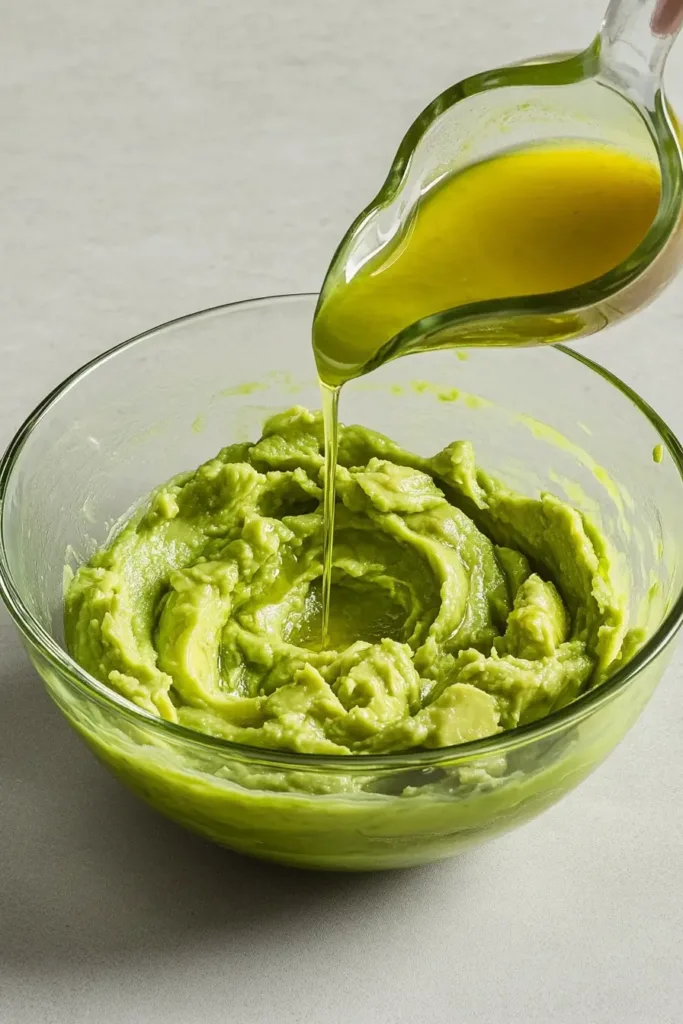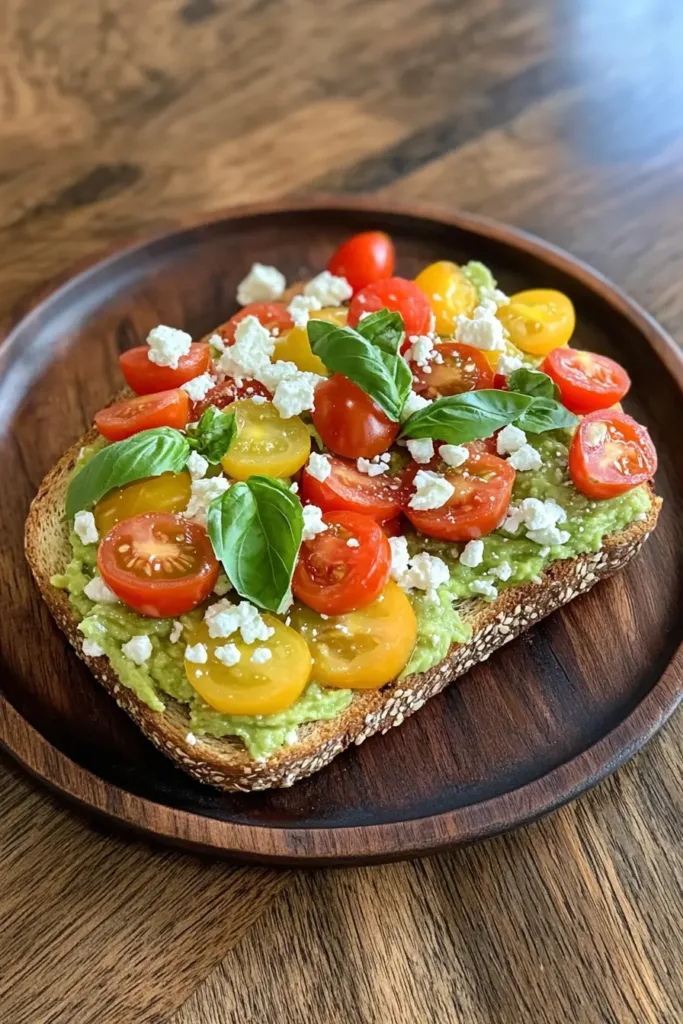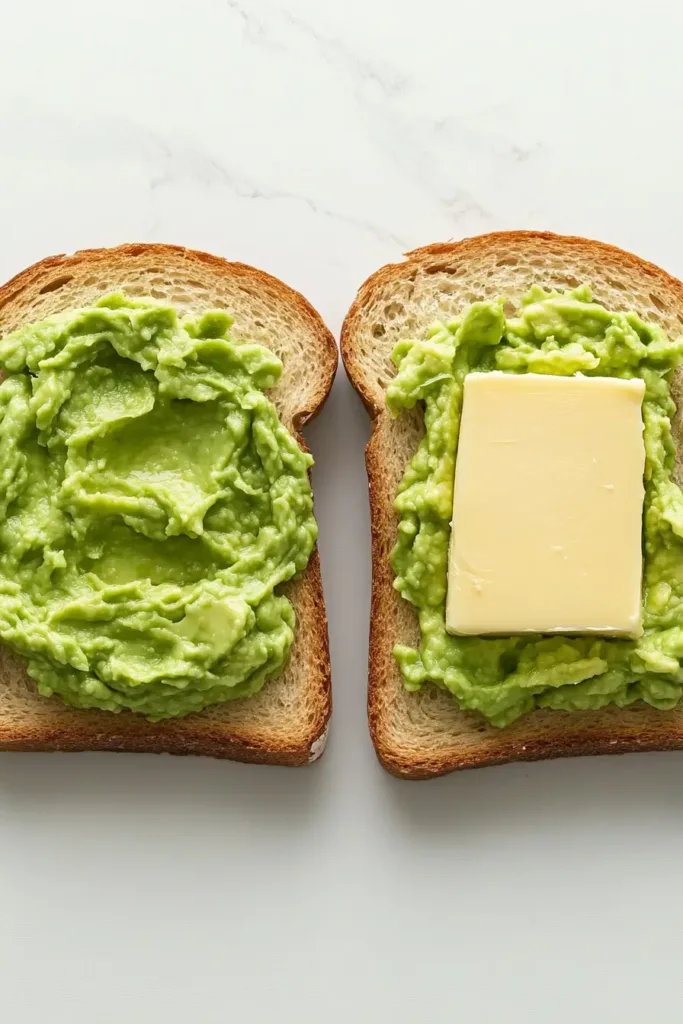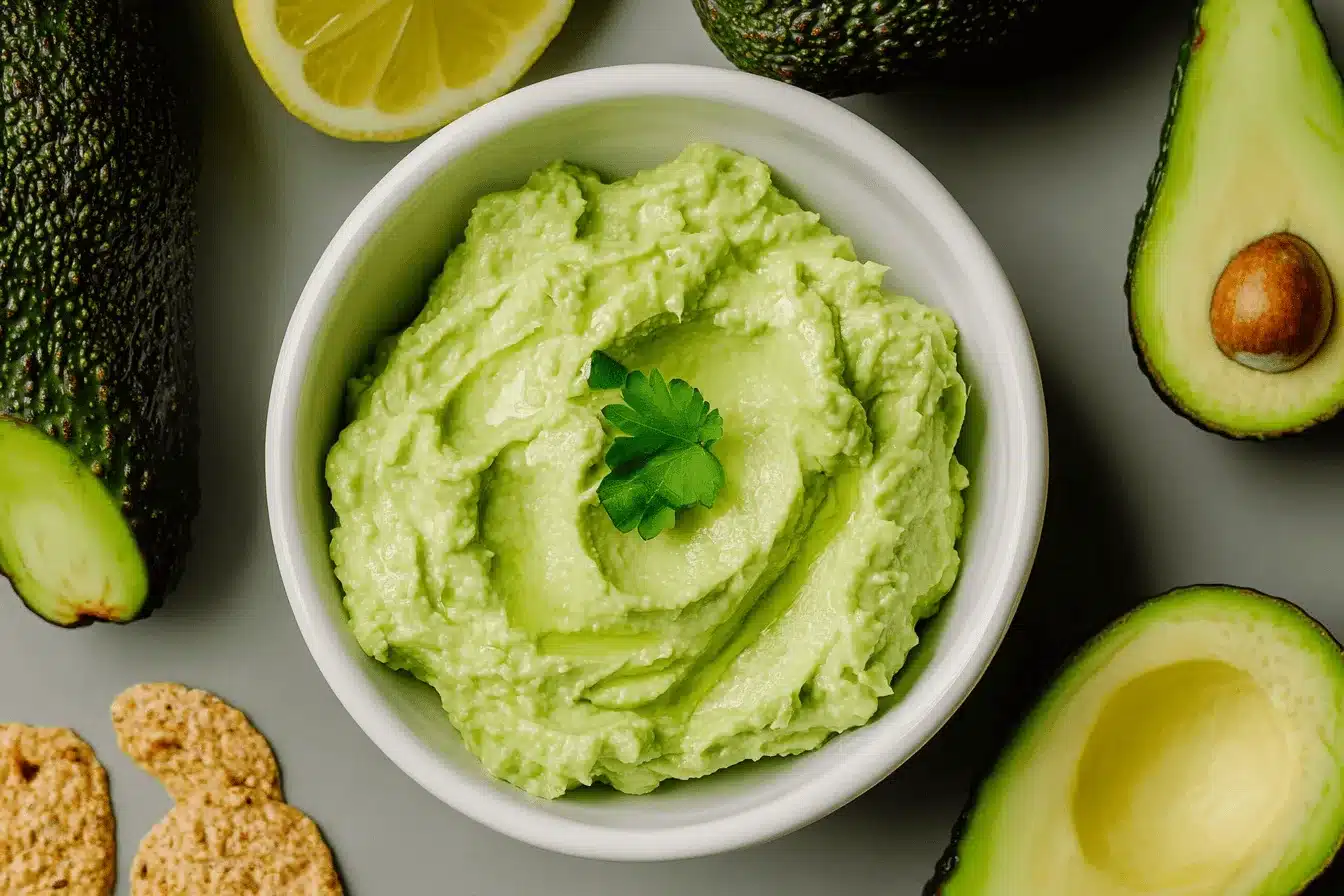Definition and Origin
Avocado spread is a smooth, creamy mixture made from ripe avocados, often combined with seasonings like lemon juice, olive oil, and salt. Unlike guacamole, which has a chunkier texture and includes ingredients like tomatoes and onions, avocado spread is blended to a smooth consistency, making it an ideal replacement for butter or mayonnaise.
👉 Looking for more delicious spread ideas? Check out this classic French Onion Dip for another flavorful option.
Nutritional Profile
One of the main reasons avocado spread has gained popularity is its impressive nutritional content. Here’s what makes it a superfood:
1. Rich in Healthy Fats
- Avocado spread is packed with monounsaturated fats, which help lower bad cholesterol (LDL) and increase good cholesterol (HDL).
- Unlike butter, which contains saturated fats, avocado spread supports heart health.
2. High in Essential Nutrients
Avocado spread contains a variety of vitamins and minerals, including:
- Vitamin E – Supports skin and immune health.
- Potassium – Helps regulate blood pressure and muscle function.
- B Vitamins – Essential for energy production and brain health.
3. Low in Sugar and Carbs
- Avocado spread is naturally low in carbohydrates and contains no added sugars, making it ideal for low-carb, keto, and diabetic-friendly diets.
| Nutrient | Per 1 tbsp of Avocado Spread | Per 1 tbsp of Butter |
|---|---|---|
| Calories | 80 | 100 |
| Total Fat | 7g (Healthy fats) | 11g (Saturated fats) |
| Fiber | 3g | 0g |
| Cholesterol | 0mg | 31mg |
Why People Love Avocado Spread
- It’s versatile – Use it on toast, sandwiches, wraps, or as a dip.
- It’s nutrient-dense – Packed with vitamins, fiber, and healthy fats.
- It’s plant-based – Perfect for vegans and those avoiding dairy.
Avocado spread is more than just a tasty topping—it’s a nutritious, heart-healthy alternative that fits into almost any diet. In the next section, we’ll dive deeper into the health benefits and why it’s a great butter substitute.
Health Benefits
Avocado spread isn’t just delicious—it’s packed with nutrients and health benefits that make it a great alternative to traditional spreads like butter or mayonnaise. Let’s explore why avocado spread is a nutrient-dense superfood and how it can benefit your overall health.
Why Avocado Spread Is a Healthier Alternative
1. Supports Heart Health
Avocados are rich in monounsaturated fats, which help:
- Lower bad cholesterol (LDL) and increase good cholesterol (HDL).
- Reduce the risk of heart disease and high blood pressure.
- Improve blood circulation and reduce inflammation.
A study published in the Journal of the American Heart Association found that eating one avocado a day can help reduce LDL cholesterol levels, making avocado spread an excellent heart-friendly choice.
2. Promotes Weight Management
Avocado spread is a high-fiber food, which means:
- It keeps you full longer, reducing the need for frequent snacking.
- It supports healthy digestion and prevents bloating.
- It may help regulate blood sugar levels, making it ideal for people with diabetes.
Just one tablespoon of avocado spread contains around 3 grams of fiber, making it a better alternative to butter or mayonnaise, which have zero fiber.
3. Provides Essential Nutrients
Avocados are packed with essential vitamins and minerals that benefit the body:
| Nutrient | Benefit |
|---|---|
| Vitamin E | Protects skin from damage and aging |
| Potassium | Helps regulate blood pressure |
| Folate | Essential for cell repair and pregnancy health |
| Magnesium | Supports muscle function and relaxation |
| B Vitamins | Boost energy production and brain function |
Unlike butter or margarine, which are mostly empty calories, avocado spread provides real nutrition that benefits your body in multiple ways.
4. Supports Brain Function & Mental Health
Avocado spread is rich in omega-3 fatty acids and folate, which are essential for:
- Cognitive function and memory – Helps protect against cognitive decline.
- Mood regulation – Healthy fats can reduce anxiety and depression.
- Reducing inflammation – Supports overall brain health.
5. Strengthens the Immune System
Thanks to its high antioxidant content, avocado spread helps:
- Fight free radicals that cause aging and disease.
- Strengthen immune defenses against infections.
- Reduce inflammation in the body, promoting overall health.
Potential Downsides of Avocado Spread
While avocado spread has many health benefits, there are a few things to keep in mind:
1. High in Calories
- Avocados are nutrient-dense but calorie-dense as well. One medium avocado contains around 240 calories, so portion control is key.
- If weight loss is your goal, stick to 1-2 tablespoons per meal instead of overloading your toast.
2. Possible Allergies and Sensitivities
- Some people with latex allergies may also be sensitive to avocados.
- Avocados are classified as high-FODMAP foods, which can cause bloating in people with IBS or digestive issues.
Final Thoughts
Avocado spread is one of the healthiest alternatives to traditional spreads. With its heart-friendly fats, fiber, and vitamins, it’s an excellent addition to your diet when consumed in moderation.
👉 For more in-depth information on avocado nutrition, check out the U.S. Department of Agriculture’s Avocado Nutrition Data.
How to Make Avocado Spread at Home
Making homemade avocado spread is incredibly easy and allows you to customize flavors to your liking. Whether you prefer it simple or with a twist, this guide will help you create the perfect spread in minutes.

Ingredients:
- 2 ripe avocados (peeled and pitted)
- 1 tablespoon lemon juice (prevents browning)
- 1 tablespoon olive oil (adds smoothness)
- ½ teaspoon salt (adjust to taste)
- ¼ teaspoon black pepper (optional)
Instructions:
- Mash the Avocados: In a bowl, use a fork to mash the avocados until smooth. For an extra creamy texture, blend in a food processor.
- Add Flavor: Stir in lemon juice, olive oil, salt, and black pepper. Mix well.
- Taste & Adjust: Add more salt, lemon juice, or olive oil as needed.
- Serve & Enjoy: Spread it on toast, use it as a dip, or add it to sandwiches.
✅ Pro Tip: If you want to keep your avocado spread fresh, cover it tightly with plastic wrap, ensuring the wrap touches the surface of the spread to prevent oxidation.
Flavor Variations
Want to add an extra kick to your avocado spread? Try these delicious variations:
1. Spicy 🔥
- Add ½ teaspoon red pepper flakes or ½ chopped jalapeño for a spicy kick.
2. Garlic & Herb 🌿
- Mix in ½ teaspoon minced garlic and 1 tablespoon chopped cilantro or parsley.
3. Creamy Yogurt 🥑
- Blend with 2 tablespoons Greek yogurt for extra protein and a tangy taste.
4. Avocado Hummus Spread 🌰
- Mix with ¼ cup hummus and a dash of cumin for a Mediterranean twist.
How to Use it
Avocado spread is versatile and can be used in many ways:
✔ On Toast – Top with eggs, tomatoes, or smoked salmon.
✔ As a Dip – Serve with veggie sticks or pita chips.
✔ In Sandwiches & Wraps – Replace mayo or butter for a healthier option.
✔ As a Salad Dressing – Mix with olive oil and lemon juice for a creamy dressing.
Storage Tips: Keeping Avocado Spread Fresh
Since avocado oxidizes and turns brown quickly, here’s how to keep it fresh:
Short-Term Storage (1-2 Days)
- Cover with Plastic Wrap: Press it directly onto the surface of the spread.
- Lemon Juice Trick: The citric acid helps slow down oxidation.
- Refrigerate Immediately: Store in an airtight container for best results.
Long-Term Storage (Freezing Method)
- Portion It: Freeze in small containers or ice cube trays.
- Thawing: Let it sit at room temperature for 30 minutes before use.
✅ Pro Tip: Never store avocados with onions or bananas in the fridge—they release gases that make avocados ripen and spoil faster.
Final Thoughts
Making homemade avocado spread is quick, easy, and healthier than store-bought options. Whether you like it simple or packed with flavor, it’s a must-try addition to your meals!
👉 If you love starting your day with healthy meals, don’t miss this Egg Muffins Recipe—a perfect pairing with avocado spread on toast!
Avocado Spread vs. Guacamole – What’s the Difference?
Avocado spread and guacamole are often confused, but they are not the same thing. While both are made from mashed avocados, their texture, ingredients, and uses differ significantly.
Key Differences Between Avocado Spread and Guacamole
| Feature | Avocado Spread | Guacamole |
|---|---|---|
| Texture | Smooth and creamy | Chunky with mixed ingredients |
| Main Ingredients | Avocado, lemon juice, olive oil, salt | Avocado, lime juice, onions, tomatoes, cilantro, spices |
| Flavor Profile | Mild and buttery | Zesty, fresh, and slightly spicy |
| Uses | Toast, sandwiches, dips, pasta, dressings | Chips, tacos, burritos, salads |
| Origin | A modern alternative to butter/mayo | Traditional Mexican dip |
✅ Main Takeaway: Guacamole is a flavorful dip with bold ingredients, while avocado spread is a simpler, creamier option that works as a versatile spread.
Ingredients Breakdown: What Sets Them Apart?
Ingredients:
- Avocado – The creamy base
- Lemon juice – Preserves freshness
- Olive oil – Adds smooth texture
- Salt & pepper – Enhances flavor
Guacamole Ingredients:
- Avocado – The star of the dish
- Lime juice – Adds a tangy kick
- Chopped onions – Provides crunch and spice
- Diced tomatoes – Adds freshness
- Cilantro – Infuses authentic Mexican flavor
- Jalapeño or chili flakes – Brings the heat
🌮 Pro Tip: If you love bold flavors, guacamole is for you. If you want something mild and versatile, go for avocado spread!
When to Use Avocado Spread vs. Guacamole
✔ Use Avocado Spread If:
- You want a buttery, mild flavor (perfect for toast or sandwiches).
- You’re replacing butter or mayo in a recipe.
- You want something smooth and spreadable.
✔ Use Guacamole If:
- You need a flavor-packed dip for nachos or chips.
- You want to enhance Mexican dishes like tacos and burritos.
- You love a chunky texture with fresh veggies.
Can You Substitute Guacamole for Avocado Spread?
In sandwiches or wraps? Yes, but the chunky texture of guacamole may be harder to spread.
- As a butter alternative? No, guacamole has extra ingredients that change the taste.
- On toast? Yes, but guacamole’s bold flavors may overpower other toppings.
✅ Final Verdict: If you need a creamy, simple spread, avocado spread is best. If you want bold, fresh flavors, guacamole is the way to go!
Final Thoughts
While both avocado spread and guacamole are made from avocados, they serve different culinary purposes. If you’re looking for a smooth, mild, and versatile option, go with avocado spread. If you want a flavorful, chunky dip, stick with guacamole.
Best Ways to Use Avocado Spread
Avocado spread is one of the most versatile condiments you can add to your meals. Whether you enjoy it on toast, as a dip, or even in pasta, its creamy texture and mild flavor make it a fantastic addition to countless dishes. Here are some of the best ways to use avocado spread to elevate your meals.

1. Avocado Spread on Toast: Classic & Creative Ideas
One of the most popular uses for avocado spread is as a toast topping. Here are some delicious variations to try:
🥑 Classic Avocado Toast
- Spread a generous layer of avocado spread on whole-grain toast.
- Sprinkle with sea salt, black pepper, and red pepper flakes.
- Add a drizzle of olive oil or balsamic glaze for extra flavor.
🍳 Protein-Packed Avocado Toast
- Top your avocado toast with a poached, fried, or scrambled egg.
- Sprinkle with everything bagel seasoning for added crunch.
- Add slices of smoked salmon or turkey for extra protein.
🍅 Mediterranean Avocado Toast
- Add feta cheese crumbles, cherry tomatoes, and olives.
- Garnish with fresh basil or oregano for a Mediterranean touch.
🌶 Spicy Avocado Toast
- Spread avocado and top with sliced jalapeños.
- Drizzle with hot honey or sriracha for a sweet-spicy kick.
2. Avocado Spread as a Sandwich or Wrap Spread
Instead of using butter, mayonnaise, or processed spreads, try avocado spread as a healthy sandwich filling. Here’s how:
✔ Replace mayo in turkey, chicken, or tuna sandwiches for a creamy texture.
✔ Use it as a spread in wraps with grilled chicken, fresh veggies, and cheese.
✔ Make a veggie sandwich with avocado spread, cucumbers, lettuce, and sprouts.
✅ Pro Tip: Mix avocado spread with a little Greek yogurt or mustard for a tangy sandwich spread!
3. Use Avocado Spread as a Dip
Avocado spread makes an excellent dip for snacks, appetizers, or even main dishes. Here are some ways to serve it:
- 🥕 With Fresh Veggies – Serve as a dip with carrots, cucumbers, and bell peppers.
- 🍟 With Baked Fries – Swap ketchup for a creamy avocado dip.
- 🧄 With Pita Chips – Mix avocado spread with hummus for a Mediterranean-style dip.
- 🌽 As a Taco Topping – Use it instead of sour cream for a healthier alternative.
✅ Pro Tip: For a thicker dip, mix avocado spread with Greek yogurt or sour cream!
4. Avocado Spread as a Pasta Sauce
Did you know you can turn avocado spread into a creamy, healthy pasta sauce? Here’s how:
🥑 Creamy Avocado Pasta Recipe
- Cook your favorite pasta (spaghetti, penne, or zucchini noodles).
- Mix ½ cup of avocado spread with ¼ cup olive oil, 2 tbsp lemon juice, and garlic.
- Toss the pasta with the avocado sauce and top with Parmesan cheese and basil.
✔ Optional Add-Ins: Add grilled chicken, shrimp, or roasted veggies for extra flavor.
5. Avocado Spread as a Salad Dressing
Turn your avocado spread into a delicious, creamy dressing for salads!
🥗 Avocado Salad Dressing Recipe
- Blend ¼ cup avocado spread with 2 tbsp olive oil, 1 tbsp lemon juice, and 1 tbsp Greek yogurt.
- Drizzle over mixed greens, cucumbers, and cherry tomatoes.
- Add protein like grilled chicken or chickpeas for a complete meal.
✅ Pro Tip: Thin out the dressing with a little water or vinegar if needed!
6. Avocado Spread for Breakfast & Snacks
Avocado spread isn’t just for toast! Here are some unique ways to enjoy it throughout the day:
✔ Breakfast Idea: Spread on whole-grain bagels, English muffins, or croissants.
✔ Snack Idea: Use as a dip for hard-boiled eggs or cheese slices.
✔ Smoothie Boost: Blend a spoonful of avocado spread into a smoothie for extra creaminess.
Final Thoughts
Avocado spread is an incredibly versatile ingredient that can be used in toast, sandwiches, dips, pasta, salads, and even breakfast recipes. Whether you’re looking for a healthy mayo substitute, a creamy dip, or a nutrient-rich dressing, avocado spread is a delicious way to upgrade your meals.
👉 Want to try another unique sandwich filling? Discover this flavorful Italian Hoagie Dip for an easy, savory option.
👉 Avocado spread also works great in salads! Try this refreshing Waldorf Salad for a perfect combination of flavors.
Why Some Doctors Warn Against Eating Too Many Avocados
Avocados are packed with healthy fats, fiber, and essential nutrients, making them a popular superfood. However, some doctors caution against overconsumption due to a few potential downsides. While avocado spread is generally a healthy choice, here are some reasons why moderation is key when eating avocados regularly.
1. High in Calories – Can Lead to Weight Gain
Avocados are calorie-dense, which means eating them in large amounts can contribute to weight gain if not balanced with overall calorie intake.
| Nutrient | 1 Medium Avocado (150g) | 1 Tbsp Avocado Spread |
|---|---|---|
| Calories | 240 kcal | 80 kcal |
| Fat | 22g (healthy fats) | 7g |
| Carbs | 12g | 3g |
| Fiber | 10g | 3g |
✅ Solution: Stick to ½ an avocado per serving or limit to 1-2 tablespoons of avocado spread at a time to avoid excess calorie intake.
2. Avocado Allergy & Latex Sensitivity
Some people experience allergic reactions to avocados, especially those with a latex allergy. This happens because avocados contain proteins similar to those found in latex, which can trigger a reaction.
Symptoms of Avocado Allergy:
- Itchy mouth, throat, or lips
- Stomach discomfort or nausea
- Skin rash or swelling
✅ Solution: If you’re allergic to latex (found in rubber gloves, balloons, or certain fruits like bananas and kiwis), you may need to limit or avoid avocados.
3. Avocados Are High in FODMAPs – May Cause Digestive Issues
Avocados contain polyols, a type of FODMAP (Fermentable Oligosaccharides, Disaccharides, Monosaccharides, and Polyols), which can cause bloating, gas, and stomach discomfort in people with irritable bowel syndrome (IBS) or sensitive digestion.
Who Should Limit Avocados?
- People with IBS or digestive issues.
- Those who experience bloating or stomach pain after eating avocados.
✅ Solution: If you have a sensitive stomach, start with a small amount (1-2 tbsp of avocado spread) and see how your body reacts.
4. Possible Medication Interactions
Avocados contain Vitamin K, which helps with blood clotting. This can interfere with blood-thinning medications like Warfarin (Coumadin). If you’re taking blood thinners, consuming too many avocados may reduce the effectiveness of your medication.
✅ Solution: If you’re on blood-thinning medication, talk to your doctor about how much avocado is safe for you.
5. Environmental Concerns – Avocado Farming & Sustainability
Avocados have a large environmental footprint due to:
- High water consumption – It takes about 70 liters (18 gallons) of water to grow one avocado.
- Deforestation – Increased avocado farming has led to deforestation in some regions.
- Carbon footprint – Avocados are often imported from faraway countries, adding to their carbon emissions.
✅ Solution: Choose locally sourced or organic avocados when possible to reduce environmental impact.
Final Thoughts
While avocado spread is a healthy and nutritious choice, it’s important to consume it in moderation to avoid excess calories, digestive discomfort, or medication interactions.
✔ Stick to 1-2 tablespoons per serving to enjoy the benefits without the downsides.
✔ If you have digestive issues, test a small amount first.
✔ Balance your diet with a variety of healthy fats, including nuts, seeds, and olive oil.
Is Avocado Spread Healthier Than Butter?
Avocado spread is often praised as a healthier alternative to butter, but is it really the better choice? In this section, we’ll compare nutritional value, health benefits, and overall impact to determine which one is the best option for your diet.

1. Nutritional Comparison: Avocado Spread vs. Butter
| Nutrient | 1 Tbsp Avocado Spread | 1 Tbsp Butter |
|---|---|---|
| Calories | 80 kcal | 100 kcal |
| Total Fat | 7g (healthy fats) | 11g (saturated fats) |
| Saturated Fat | 1g | 7g |
| Cholesterol | 0mg | 31mg |
| Fiber | 3g | 0g |
| Vitamins | Vitamin E, B6, Folate | Vitamin A, D, K2 |
✅ Winner: Avocado Spread – It contains less saturated fat, more fiber, and zero cholesterol, making it the heart-healthier choice.
2. Heart Health: Which Is Better for Your Cardiovascular System?
✔ Avocado Spread: Contains monounsaturated fats, which reduce LDL (bad cholesterol) and increase HDL (good cholesterol). It also has zero cholesterol, making it ideal for heart health.
❌ Butter: High in saturated fat and cholesterol, which can contribute to heart disease and high blood pressure. While butter contains some beneficial fat-soluble vitamins, too much saturated fat is linked to heart risks.
✅ Winner: Avocado Spread – It actively helps improve heart health, unlike butter.
3. Weight Management: Which One Is Better for a Healthy Diet?
✔ Avocado Spread:
- High in fiber, which helps you feel fuller longer and curbs cravings.
- Supports healthy metabolism due to its monounsaturated fats.
❌ Butter:
- More calorie-dense than avocado spread.
- No fiber, meaning it won’t keep you full as long.
- Saturated fats are harder to burn for energy compared to monounsaturated fats.
✅ Winner: Avocado Spread – A more filling, nutrient-dense option for weight management.
4. Versatility & Taste: Which One Works Best in Recipes?
✔ Avocado Spread Works Best For:
- Toast & sandwiches – A great butter or mayo substitute.
- Salads & dressings – Can be blended into creamy dressings.
- Dips & spreads – Works well as a base for hummus or guacamole.
✔ Butter Works Best For:
- Baking & pastries – Provides flakiness and richness in baked goods.
- Cooking & frying – Adds a rich, buttery flavor that avocado spread can’t replicate.
- Topping hot foods – Melts better on pancakes, waffles, or popcorn.
✅ Winner: Tie – Avocado spread is better for healthy eating, but butter excels in baking and high-heat cooking.
5. Which One Is More Sustainable?
🌱 Avocado Farming Issues:
- High water consumption – One avocado requires 70 liters (18 gallons) of water to grow.
- Deforestation concerns – Avocado demand has led to deforestation in some areas.
- Carbon footprint – Many avocados are imported, increasing transportation emissions.
🐄 Butter Production Issues:
- High methane emissions – Dairy cows contribute to greenhouse gas emissions.
- Ethical concerns – Dairy farming practices raise animal welfare issues.
- Land & resource use – Producing 1 pound of butter requires 21 pounds of milk.
✅ Winner: Avocado Spread (but only if sourced from sustainable farms).
Final Verdict: Which One Should You Choose?
If you want a heart-healthy, nutrient-dense alternative, avocado spread is the clear winner. It provides healthy fats, fiber, and zero cholesterol, making it a better choice for overall wellness.
However, butter still has its place in baking, high-heat cooking, and traditional recipes.
Best Choice for a Healthy Diet? 🥇 Avocado Spread
Best Choice for Baking & Cooking? 🥇 Butter
Final Thoughts
✔ If you want a healthier alternative to butter, switch to avocado spread for everyday use.
✔ If you’re baking cakes, cookies, or pastries, butter is still the better choice.
✔ Try using avocado spread in place of mayo or butter on toast, sandwiches, or dips for a healthier alternative.
How to Store Avocado Spread for Freshness
One of the biggest challenges with avocado spread is keeping it fresh and preventing it from turning brown. Since avocados oxidize quickly when exposed to air, proper storage is key to maintaining their vibrant green color and creamy texture. In this section, we’ll cover the best short-term and long-term storage methods for avocado spread.
1. Why Does Avocado Spread Turn Brown?
When avocados are exposed to air, they undergo oxidation, which causes the spread to turn brown. While it may not look appealing, brown avocado spread is still safe to eat—but it may develop a slightly bitter taste.
✅ Good news: With the right storage techniques, you can keep your avocado spread fresh for up to 3 days in the fridge or several months in the freezer!
2. Short-Term Storage (1-3 Days in the Refrigerator)
If you plan to eat your avocado spread within a few days, store it in the fridge using these methods:
Method 1: Plastic Wrap Trick (Best for 1-2 Days)
- Transfer avocado spread to an airtight container.
- Press plastic wrap directly onto the surface to minimize air exposure.
- Seal the container and refrigerate.
✔ Pros: Easy and effective.
❌ Cons: Only lasts 1-2 days before slight browning occurs.
Method 2: Lemon Juice or Lime Juice (Best for 2-3 Days)
- Stir ½ teaspoon of lemon or lime juice into the avocado spread before storing.
- Store in an airtight container.
✔ Pros: Citric acid slows oxidation.
❌ Cons: Can slightly alter the taste.
Method 3: Water Seal Method (Best for 3+ Days)
- Place avocado spread in a container and smooth the surface with a spoon.
- Pour a thin layer of water or olive oil on top to create a protective seal.
- When ready to eat, drain the water and stir before serving.
✔ Pros: Keeps avocado spread fresh the longest!
❌ Cons: May slightly change texture if too much water is added.
✅ Pro Tip: Avoid storing avocado spread in metal containers, as they can cause faster oxidation. Use glass or plastic instead.
3. Long-Term Storage (Freezing for Up to 3 Months)
If you want to make avocado spread in advance, freezing is a great option!
How to Freeze Avocado Spread:
- Portion the spread into small, airtight containers or ice cube trays.
- Add a few drops of lemon or lime juice to each portion.
- Cover the container tightly with plastic wrap, then seal with a lid.
- Label with the date and freeze for up to 3 months.
How to Thaw Frozen Avocado Spread:
- Transfer from the freezer to the refrigerator and let it thaw for a few hours or overnight.
- Stir well before using.
✅ Best For: Meal prep, batch cooking, and reducing food waste!
❌ Not Ideal For: Spreading on toast (frozen avocado spread can become slightly watery).
4. Common Storage Mistakes to Avoid
🚫 Mistake #1: Storing Avocado Spread Without a Seal
- Always use plastic wrap, an airtight lid, or a water seal to prevent oxidation.
🚫 Mistake #2: Keeping It at Room Temperature for Too Long
- Avocado spread spoils quickly if left out. Refrigerate immediately!
🚫 Mistake #3: Using a Metal Container
- Metal can speed up oxidation, so always use glass or BPA-free plastic.
🚫 Mistake #4: Forgetting to Add Lemon or Lime Juice
- Even if you store it properly, adding a little citrus juice extends freshness.
5. How to Tell If Avocado Spread Has Gone Bad
Even with the best storage methods, avocado spread won’t last forever. Here are signs that it’s time to throw it out:
❌ Deep brown or gray color (beyond surface oxidation).
❌ Sour or off smell (avocados should smell mild and fresh).
❌ Mold or fuzzy spots (even a little mold means it’s unsafe to eat).
✅ Pro Tip: If only the top layer is brown, scrape it off—what’s underneath may still be fresh!
Final Thoughts
Keeping avocado spread fresh is easy with the right storage methods. Whether you need to store it for a few days or a few months, these simple tricks will help maintain its vibrant green color and delicious taste.
✔ For short-term storage, use plastic wrap, lemon juice, or a water seal.
✔ For long-term storage, freeze in small portions for up to 3 months.
✔ Always store in an airtight container to prevent oxidation.
In Part 9, we’ll answer the most common questions about avocado spread—including how it compares to guacamole, its health benefits, and more!
Frequently Asked Questions (FAQs)
Avocado spread is a delicious, healthy alternative to traditional spreads, but many people have questions about how it’s made, stored, and how it compares to other options. Here are answers to some of the most frequently asked questions about avocado spread!
How long does homemade avocado spread last?
Can I use avocado spread as a butter substitute?
Is avocado spread good for weight loss?
Final Thoughts
Avocado spread is one of the healthiest, most versatile spreads you can add to your diet. Whether you’re looking for a butter substitute, a creamy dip, or a nutritious toast topper, avocado spread is a delicious and heart-healthy choice.
✔ Great for heart health, digestion, and weight management.
✔ Lasts 1-3 days in the fridge, or up to 3 months in the freezer.
✔ Works well in toasts, sandwiches, dips, pasta, and salads!
👉 Love comfort food? You’ll enjoy this homemade American Goulash Recipe—hearty, flavorful, and easy to make!
👉 Looking for a fun snack? These Pretzel Bites are perfect for dipping in creamy avocado spread!
Table of Contents

Avocado Spread
Ingredients
- 2 ripe avocados peeled and pitted
- 1 tablespoon lemon juice
- 1 tablespoon olive oil
- ½ teaspoon salt
- ¼ teaspoon black pepper optional
Instructions
- Mash the avocados in a bowl with a fork until smooth, or blend in a food processor for a creamier texture.
- Stir in lemon juice, olive oil, salt, and black pepper. Mix well.
- Taste and adjust seasoning as needed.
- Serve immediately or store using the plastic wrap method to keep it fresh.

